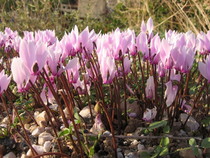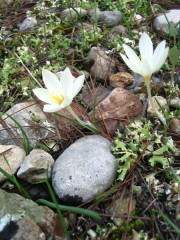Autumn Flora
Pretty In Pink
On hillsides, in woodlands, along waysides – in clumps and clusters under small bushes and between rocks – the Cyclamen are now well established and can be seen everywhere in abundance. Their delicate and rich pink flowers stretch upwards on long, thin stems, as if trying to reach for the watery blue skies of October. Their dark green, marbled and veined leaves start to uncurl slightly later, followed by the flower stalks coiled into tiny little spirals, trying hard to protect the fruit inside.
Of the twenty species of Cyclamen, the Greek Sowbread, along with the Ivy-leaved Sowbread are both autumn flowering, as opposed to other types that flower in late winter and early spring. Growing equally well in a dry garden as in the wild, normal seed sowing should take place in October-November, with seeds needing as much as ten hours to soak beforehand.
However, moving the actual plant from the wild to the garden is not often successful, as they do not like to be moved.When buying an established Cyclamen they can happily stay in pots all winter, although you will have to create similar conditions to that of their natural habitat. Occupying the corner of a balcony, terrace or on a windowsill with as much light as a winter Mediterranean woodland, should be enough to ensure good, continued growth. If however, it turns yellow in late spring, then this is nothing to worry about as it will not be too late to re-plant it in the garden. Just stop watering it and move the corm from its now dry soil and wait until it pops its head above ground again the following autumn. A good place would be under deciduous trees, the bottom of stone walls or in flower beds.
Not only very pink and very pretty, in ancient Greece, the Cyclamen was very popular as a remedy. Greek writers and physicians proclaimed its healing benefits and the tuber juice was used on wounds and boils and also during childbirth. It was thought to bring good luck and serve as an aphrodisiac too and in those times was known as chelonian. This was after the Greek word chelona, meaning tortoise, as it was thought that its tubers bore a likeness to that of the small creature. The modern name however could possibly be a derivation from the Greek word kyklos, meaning circle. This was probably named as such, due to the rounded tuber or rolled up stalk. From past to present and then on to the future, the Cyclamen – if looked after well – can survive anything up to fifty years and may well be around long enough to see you re-potted!
...and pretty in purple, yellow and white...
Of the 80 worldwide species of Crocus, the equally delightful, autumn blooming Crocus Boryi, with its flowers of white and purple and yellow tongue can also be seen all over hillsides and along paths and walkways, happily sprouting from hard soil. Plant in late summer for autumn flowering, and make sure they lie about 5cm under the ground. Many self-seed but to be sure, take cormlets off existing crocus and plant when dormant. Flowers will close at night and on days with cloud but on those bright sunny days throughout October and November they will thrive.
All in all, November is definitely the busiest month for gardening. A time for seedlings (from September sown seeds) to be planted...a time for easy digging in soft ground ensured by the October rains...a time when days are still warm enough to guarantee swift growth of small trees and shrubs just planted or moved...a time to enjoy the warm midday sun before the cold weather strikes and sets in for the winter.
PRETTY IN PINK: COPYRIGHT LUCY PARASKEVA












